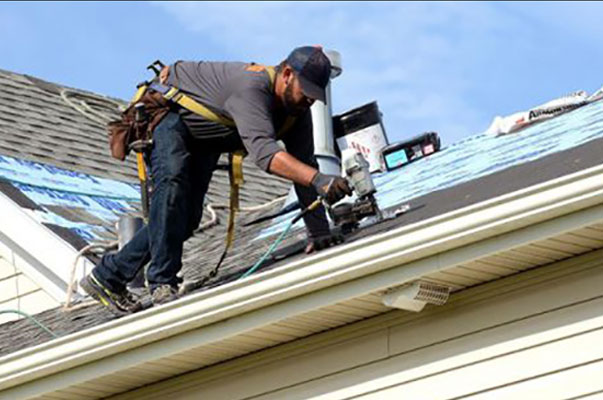Protecting Your Nampa Home from the Top Down
Your roof is your home’s first line of defense against Nampa’s distinct seasons—from hot, sunny summers to cold, snowy winters. But like any part of your property, it has a lifespan. Over time, exposure to sun, wind, rain, and hail can take its toll, leading to potential issues that compromise the safety and integrity of your home. Recognizing the signs of a failing roof is crucial for preventing minor issues from becoming major, costly problems. This guide will help you identify when it’s time to consider a residential roofing replacement and what to look for in a trusted local contractor.
Key Warning Signs Your Roof Needs Replacement
Don’t wait for a leak to appear in your living room. Proactive inspection can save you significant stress and money. Look for these common indicators of a worn-out roof:
Curled or Missing Shingles
Shingles should lie flat. If you see edges curling up or patches where shingles are completely gone, your roof is vulnerable. This is often a sign of advanced age or significant wind and hail damage, exposing the underlayment to moisture.
Granules in the Gutters
Asphalt shingles are coated with granules that protect them from UV rays. When these wear away, you’ll find them collecting in your gutters. This “balding” indicates your shingles are nearing the end of their effective life.
Leaks and Water Stains
The most obvious sign of a problem. Check your attic regularly for signs of water intrusion, dark spots, or sagging. On interior ceilings, look for discoloration or peeling paint. A small leak can lead to widespread structural damage and mold growth if ignored.
Benefits of a New Roof: More Than Just a Repair
Investing in a new roof offers benefits that extend far beyond simply keeping the rain out. It’s an upgrade to your entire home.
Boost Your Home’s Value and Curb Appeal
A new roof is a major selling point for potential buyers. It not only improves the aesthetic of your property but also gives the next owner peace of mind. Modern roofing materials come in a variety of styles and colors to perfectly match your home’s architecture.
Improve Energy Efficiency
Older roofs often lack modern underlayment and ventilation technology. A new roofing system can improve airflow in your attic, reducing the burden on your HVAC system during Nampa’s hot summers and keeping your home warmer in the winter. This often translates to lower monthly energy bills.
Ensure Structural and Family Safety
A failing roof can lead to serious structural issues with rafters, joists, and wall framing. A new roof, professionally installed, ensures your home is structurally sound and protects your family from the elements and potential hazards like mold growth caused by hidden leaks.
Did You Know?
The average asphalt shingle roof has a lifespan of 20-30 years. However, the intense sun and storm cycles in the Treasure Valley can sometimes shorten this. If your roof is approaching the 20-year mark, a professional inspection is a wise investment to assess its remaining life and catch any potential problems early.
The Nampa Climate and Your Roof
Living in Nampa means your roof needs to withstand a wide range of weather conditions. The intense summer sun can cause thermal shock, expanding and contracting roofing materials, which leads to cracking. Winter brings snow and the risk of ice dams, where melted snow refreezes at the edge of the roof, forcing water up under the shingles. This is why professional installation with proper ice and water shields is non-negotiable in our region. When considering a roof repair or replacement, it’s essential to choose materials and a contractor familiar with the specific challenges of the Treasure Valley climate.
Choosing the Right Nampa Roofing Contractor
Your roofing contractor is your partner in protecting your most valuable asset. Look for a company that is:
- Local and Experienced: A contractor based in the Treasure Valley understands local building codes and weather challenges. longevity in the community is a sign of reliability.
- Licensed and Insured: Protect yourself. Ensure your contractor carries full liability insurance and worker’s compensation.
- An Insurance Claim Specialist: If your roof has storm damage, you need a team that can work directly with your insurance company. This simplifies the process, ensuring all damage is documented and your roof insurance claim is handled correctly.
- Transparent with Free Estimates: A reputable company will offer a complimentary, no-obligation inspection and a detailed estimate outlining all costs.
Team Construction is proud to be a locally owned and operated contractor meeting all these standards for homeowners in Nampa and across the Treasure Valley.
Don’t Wait for a Disaster to Strike
A proactive approach to your roof’s health will protect your home and save you money. If you’ve noticed any of the signs mentioned or your roof is over 15 years old, it’s time for a professional assessment.
Frequently Asked Questions
How long does a typical roof replacement take in Nampa?
For an average-sized home, a full residential roof replacement can usually be completed in 1 to 3 days. The timeline can be affected by factors like the weather, the complexity of the roof’s design, and the type of materials being installed.
What is the best type of roofing material for Idaho’s weather?
Architectural asphalt shingles are an excellent and popular choice for the Treasure Valley. They offer superior durability, wind resistance, and longevity compared to standard 3-tab shingles. They also come in a wide range of styles to enhance your home’s curb appeal.
Will my homeowner’s insurance cover a new roof?
Homeowner’s insurance typically covers roof replacement if the damage is caused by an “act of God,” such as a hail or wind storm. It generally does not cover replacement due to old age or lack of maintenance. At Team Construction, we offer free inspections and can help you determine if you have a valid claim and assist you through the entire insurance restoration process.
